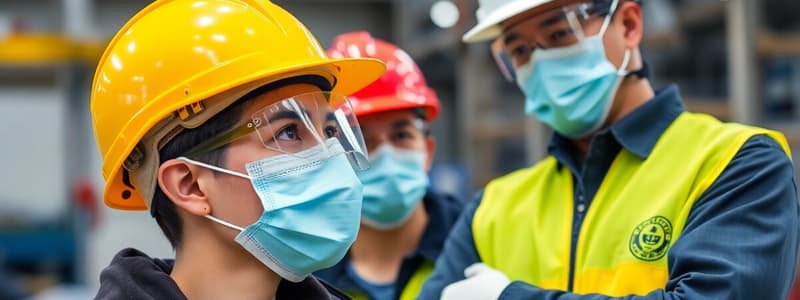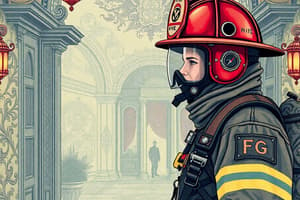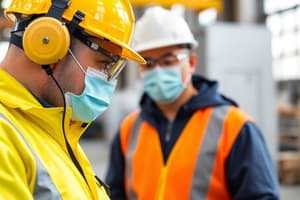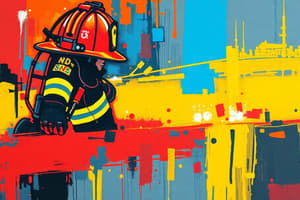Podcast
Questions and Answers
What is the recommended eye protection for workers who wear prescription glasses?
What is the recommended eye protection for workers who wear prescription glasses?
- Only contact lenses
- Standard sunglasses
- Safety glasses with side shields under a face shield (correct)
- Safety glasses without side shields
At what dB level is hearing protection required?
At what dB level is hearing protection required?
- 75 dB
- 85 dB
- 95 dB
- 90 dB (correct)
Which of the following is NOT an example of hearing protection?
Which of the following is NOT an example of hearing protection?
- Molded ear plugs
- Disposable foam plugs
- Regular headphones (correct)
- Noise cancelling ear plugs
Why is it important to consider the Noise Reduction Rating (NRR) of hearing protection devices?
Why is it important to consider the Noise Reduction Rating (NRR) of hearing protection devices?
What is the potential risk of exposure to noise levels over 85 dB?
What is the potential risk of exposure to noise levels over 85 dB?
Which type of hearing protection would provide the least noise reduction?
Which type of hearing protection would provide the least noise reduction?
What type of safety glasses should be worn under a face shield?
What type of safety glasses should be worn under a face shield?
Corrective lenses must be worn in addition to which type of eye protection?
Corrective lenses must be worn in addition to which type of eye protection?
What is a primary reason employers must provide hand protection to employees?
What is a primary reason employers must provide hand protection to employees?
Which type of glove is specifically designed for handling materials that emit vibrations?
Which type of glove is specifically designed for handling materials that emit vibrations?
What is NOT a common cause of foot injuries in the workplace?
What is NOT a common cause of foot injuries in the workplace?
Which type of glove provides protection against chemical exposure?
Which type of glove provides protection against chemical exposure?
What type of hazard does thermal burn protection specifically address?
What type of hazard does thermal burn protection specifically address?
When are employers required to provide foot protection?
When are employers required to provide foot protection?
Which of the following gloves would be best suited for preventing severe cuts or lacerations?
Which of the following gloves would be best suited for preventing severe cuts or lacerations?
What type of hazard can sharp objects on the ground cause?
What type of hazard can sharp objects on the ground cause?
What is the primary purpose of Class C hard hats?
What is the primary purpose of Class C hard hats?
Which of the following is not a common cause of eye injuries?
Which of the following is not a common cause of eye injuries?
What certification should safety glasses meet according to the provided standards?
What certification should safety glasses meet according to the provided standards?
Which of the following is a key consideration when selecting eye and face protection?
Which of the following is a key consideration when selecting eye and face protection?
What does Class C hard hats primarily protect against?
What does Class C hard hats primarily protect against?
Which of the following features is not important for safety glasses?
Which of the following features is not important for safety glasses?
Which category of hazards do Class C hard hats not protect against?
Which category of hazards do Class C hard hats not protect against?
What factor is least likely to be considered in the selection of eye protection?
What factor is least likely to be considered in the selection of eye protection?
What type of footwear may be specialized for certain hazardous conditions?
What type of footwear may be specialized for certain hazardous conditions?
Which of the following is NOT a cause of bodily injuries mentioned?
Which of the following is NOT a cause of bodily injuries mentioned?
What feature is essential for footwear that protects against impact?
What feature is essential for footwear that protects against impact?
Which type of protection is necessary for those working with hot liquids?
Which type of protection is necessary for those working with hot liquids?
What type of body protection might be necessary for exposure to hazardous chemicals?
What type of body protection might be necessary for exposure to hazardous chemicals?
Metal shanks in footwear are primarily designed to provide protection against what?
Metal shanks in footwear are primarily designed to provide protection against what?
Which of the following is a factor to consider when selecting body protection gear?
Which of the following is a factor to consider when selecting body protection gear?
What is one potential reason for needing metatarsal guards in footwear?
What is one potential reason for needing metatarsal guards in footwear?
What is one of the responsibilities of employers regarding workplace hazards?
What is one of the responsibilities of employers regarding workplace hazards?
How should employers address workplace hazards?
How should employers address workplace hazards?
Who is ultimately responsible for providing PPE to employees?
Who is ultimately responsible for providing PPE to employees?
What must be done before selecting PPE for a workplace?
What must be done before selecting PPE for a workplace?
What is NOT an employer's responsibility in regard to workplace safety?
What is NOT an employer's responsibility in regard to workplace safety?
Which of the following is an example of a hazard that might require PPE?
Which of the following is an example of a hazard that might require PPE?
What should be prioritized after identifying workplace hazards?
What should be prioritized after identifying workplace hazards?
PPE selection should be based on which of the following factors?
PPE selection should be based on which of the following factors?
Flashcards are hidden until you start studying
Study Notes
Hard Hats
- Class C hard hats are designed for comfort and offer limited protection.
- They protect against bumping against fixed objects.
- They do not protect against falling objects or electrical hazards.
Eye and Face Protection
- Common causes of eye injuries include dust, flying particles, harmful chemicals, and intense light.
- Eye and face protection should meet the requirements of ANSI Z87.
- Eye and face protection selection should consider ability to protect, fit and comfort, vision and movement not restricted, durability and cleanability, and compatibility with other PPE.
Respiratory Protection
- Respiratory protection is an important component of personal protective equipment (PPE) to safeguard against airborne hazards.
- Workers should be protected from inhaling harmful dust, fumes, gases, and vapors.
Hearing Protection
- Exposure to over 85 dB can cause hearing loss.
- Hearing protection is required at 90 dB.
- Effective hearing protection should be part of a comprehensive hearing conservation program.
- Examples of hearing protection include disposable foam plugs, molded ear plugs, noise-cancelling earplugs, and ear muffs.
- It is essential to consider the Noise Reduction Rating (NRR) of hearing protection devices.
Hand and Arm Protection
- Employers are required to provide hand protection when employees are exposed to hazards.
- These hazards include skin absorption of harmful substances, severe cuts or lacerations, severe abrasions, punctures, chemical and thermal burns, and harmful temperature extremes.
Types of Gloves
- Different types of gloves provide protection against specific hazards, such as:
- Anti-vibration gloves
- Leather palm gloves
- Heat-resistant gloves
- Permeation-resistant gloves
- Cut-resistant gloves
Foot and Leg Protection
- Foot injuries in construction can be caused by heavy objects, sharp objects, molten metal, hot surfaces, slippery or wet surfaces, and electrical hazards.
- Impact-resistant toe and/or instep protection is recommended for footwear.
- Steel and composite toe protection are readily available.
- Additional considerations for footwear include heat-resistant soles, metal shanks, and specialty footwear for specific hazards like metatarsal guards, liquid or chemical resistance, and conductive or nonconductive properties.
Body Protection
- Bodily injuries can be caused by intense heat, splashes of hot metals or hot liquids, impacts from tools, machinery, or materials, sharp objects, hazardous chemicals, contact with potentially infectious materials, and radiation.
- Examples of body protection include:
- Flame-resistant clothing
- Protective aprons
- Protective jackets
- Insulated gloves
- Eye protection
- Respirators
- Hearing protection
- Safety belts
- Work boots
Hazard Recognition
- Workers should be able to identify hazards in their workplace and select the appropriate PPE to address those hazards.
Employer Responsibilities
- Employers must assess the workplace for hazards.
- They must implement engineering and work practice controls to eliminate or reduce existing hazards.
- Employers must select and provide suitable PPE at no cost to employees to ensure their safety.
Knowledge Check
- Employers are responsible for providing PPE to their employees.
Studying That Suits You
Use AI to generate personalized quizzes and flashcards to suit your learning preferences.




